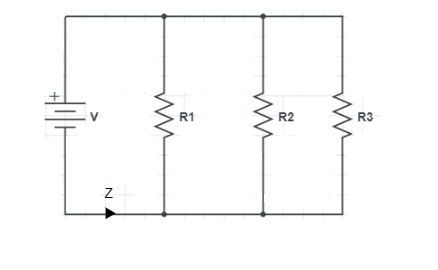
How can I calculate voltage drop in a parallel circuit?
Answer
546.6k+ views
Hint: This can be solved by using ohm’s law which states that voltage across a conductor is directly proportional to the current flowing through it, and for parallel circuits we will use formula for total resistance to find total voltage drop.
Formula used:
$\begin{align}
& V=IR \\
& R={{R}_{1}}+{{R}_{2}}+{{R}_{3}} \\
\end{align}$
Complete step by step solution:
The voltage drop across a resistor in a parallel circuit is the same across all the resistors in each branch of all the parallel circuits in the parallel circuit diagram.
Voltage expressed in voltage measures the electromotive forces that drive the circuit or the potential difference.
Consider a circuit with the three resistors connected in parallel and with the voltage supply ‘V’ and the current flowing in ‘I’.

Now step by step method to calculate voltage across the circuit,
Step 1:- find the total resistance of the parallel circuit.
Formula for total resistance for the circuit connected in parallel,
$\begin{align}
& \Rightarrow \dfrac{1}{{{R}_{T}}}=\dfrac{1}{{{R}_{1}}}+\dfrac{1}{{{R}_{2}}}+\dfrac{1}{{{R}_{3}}} \\
& \therefore {{R}_{T}}=\dfrac{{{R}_{1}}{{R}_{2}}{{R}_{3}}}{{{R}_{1}}{{R}_{2}}+{{R}_{2}}{{R}_{3}}+{{R}_{1}}{{R}_{3}}}....\left( 3 \right) \\
\end{align}$
Now according to the ohm’s law,
$\Rightarrow V=I{{R}_{T}}$
Where, V = voltage
I = current
${{R}_{T}}$ = total resistance
$\Rightarrow V=\dfrac{I\times {{R}_{1}}{{R}_{2}}{{R}_{3}}}{{{R}_{1}}{{R}_{2}}+{{R}_{2}}{{R}_{3}}+{{R}_{3}}{{R}_{4}}}....\left( 1 \right)$
Consider this method because according to Kirchhoff’s current law, the amount of the current entering in the circuit is equal to amount of the current leaving the circuit.
Note:
As an approach to solve this question we use ohm’s law to find voltage across a circuit of the resistor which are connected in parallel using total resistance of parallel circuit and total amount of current flowing in the circuit.
Formula used:
$\begin{align}
& V=IR \\
& R={{R}_{1}}+{{R}_{2}}+{{R}_{3}} \\
\end{align}$
Complete step by step solution:
The voltage drop across a resistor in a parallel circuit is the same across all the resistors in each branch of all the parallel circuits in the parallel circuit diagram.
Voltage expressed in voltage measures the electromotive forces that drive the circuit or the potential difference.
Consider a circuit with the three resistors connected in parallel and with the voltage supply ‘V’ and the current flowing in ‘I’.

Now step by step method to calculate voltage across the circuit,
Step 1:- find the total resistance of the parallel circuit.
Formula for total resistance for the circuit connected in parallel,
$\begin{align}
& \Rightarrow \dfrac{1}{{{R}_{T}}}=\dfrac{1}{{{R}_{1}}}+\dfrac{1}{{{R}_{2}}}+\dfrac{1}{{{R}_{3}}} \\
& \therefore {{R}_{T}}=\dfrac{{{R}_{1}}{{R}_{2}}{{R}_{3}}}{{{R}_{1}}{{R}_{2}}+{{R}_{2}}{{R}_{3}}+{{R}_{1}}{{R}_{3}}}....\left( 3 \right) \\
\end{align}$
Now according to the ohm’s law,
$\Rightarrow V=I{{R}_{T}}$
Where, V = voltage
I = current
${{R}_{T}}$ = total resistance
$\Rightarrow V=\dfrac{I\times {{R}_{1}}{{R}_{2}}{{R}_{3}}}{{{R}_{1}}{{R}_{2}}+{{R}_{2}}{{R}_{3}}+{{R}_{3}}{{R}_{4}}}....\left( 1 \right)$
Consider this method because according to Kirchhoff’s current law, the amount of the current entering in the circuit is equal to amount of the current leaving the circuit.
Note:
As an approach to solve this question we use ohm’s law to find voltage across a circuit of the resistor which are connected in parallel using total resistance of parallel circuit and total amount of current flowing in the circuit.
Recently Updated Pages
Master Class 12 Economics: Engaging Questions & Answers for Success

Master Class 12 Maths: Engaging Questions & Answers for Success

Master Class 12 Biology: Engaging Questions & Answers for Success

Master Class 12 Physics: Engaging Questions & Answers for Success

Basicity of sulphurous acid and sulphuric acid are

Master Class 12 Business Studies: Engaging Questions & Answers for Success

Trending doubts
What are the major means of transport Explain each class 12 social science CBSE

Which are the Top 10 Largest Countries of the World?

Draw a labelled sketch of the human eye class 12 physics CBSE

How much time does it take to bleed after eating p class 12 biology CBSE

Explain sex determination in humans with line diag class 12 biology CBSE

Differentiate between homogeneous and heterogeneous class 12 chemistry CBSE




